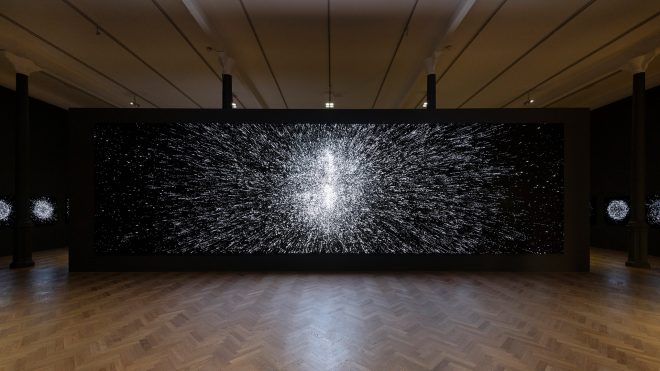Technology lies at the heart of Leo Villareal’s art. For over 20 years, the Albuquerque-born, New York-based artist has been using pixels and binary code as key ingredients in his artistic experiments, after having “stumbled across the connection between software and light”, which then blossomed into a career-defining fascination.
“I started out with very simple arrays of light with the lowest level of code: zero’s off, and one is on,” Villareal explains. His light artworks have since evolved to harness more information, more intricate sequences, and more ambitious scales, however he still values core concepts – such as emergent behaviour or artificial life – over the medium.
“My interest has always been art first, then technology, but also using technology in a way that it’s very much a tool serving the idea, and not just technology for technology’s sake,” he tells us. “I think [that] is a danger with much of digital work, because the medium is so seductive and powerful that it can take over very easily.”
Top image: installation view of Detector (2019). All images: Damian Griffiths, courtesy Pace Gallery
Nonetheless, technology sits front and centre of Villareal’s new solo exhibition at Pace Gallery in London. The components are purposefully laid bare for us to examine – right down to the LED panels used for some works, which emphasise the binaries of the code thanks to a reduced pixel density. While many motion pieces are nowadays focused on sleek transitions and smoothing out patterns, Villareal consciously highlights pixel traces and abrupt markings that nod to seminal artworks – from Roy Lichtenstein’s pop art to Gustave Doré’s etchings based on Dante.
The gallery space is dominated by Detector, a mammoth new installation clocking in at over 10 metres in width, the size enhancing the galactic quality of the light sequences. Here, it’s not simply a case of ‘bigger equals better’. For Villareal, scale invites communality – a driving factor behind his love of public art. He likes the idea of groups gathering in front of his work and sharing an ultimately subjective experience in the presence of one another.
His work began in virtual reality before he pivoted to public art. Villareal had gone to graduate school and interned in a Silicon Valley research lab so he could get his hands on these then million dollar tools. “But what I ended up finding was a very empty world – you needed these head-mounted displays, and all these devices, and a special chair,” he recalls.
“If you had all these things then you could achieve this virtual world, but it ended up being very lonely. You were there, isolated, and it was not interesting to me – and then I realised I could make these light sculptures that had a similar ability to transport people and take people on a journey, but without encumbering them.”
Central to Villareal’s practice is appropriating familiar materials as a canvas for his work. As part of his ongoing project Illuminated River, he has been transforming bridges along the River Thames in London into colourful light sculptures, elevating them from functional to beautiful. Elsewhere, he takes LED screens out of an advertising context and drops them into an artistic one. “Usually these things have a very specific agendas about ‘go here’, ‘buy this’, ‘do this’, but this is a very undirected kind of experience that I think expresses a sense of freedom to a viewer, and to enjoy this technology without feeling like you’re being pushed in any direction,” he says.
Villareal hopes that by making his work feel directionless, it will eliminate the sense of anxiety that visitors often feel at exhibitions. There’s no order to viewing the works, and it’s not really possible to ‘miss’ part of an ever-changing visualisation. “Here, you come in and it doesn’t matter what happened before – you can just engage with it and it’s very much up to you what it is,” he says.
Villareal’s work is dedicated to “dragging these digital things out into the world”, something he believes is vital as questions around technologies continue to arise. “I do think that we can find a way to make [technology] part of our lives,” he says – but we have to be able to get up close and personal with it. “It’s very important that people are present with the work, that they can see it with their own eyes and not reproductions of it.”
That’s not to say it’s essential to him that people understand the technologies behind his works. “To me, it’s very important that people are able to look at a piece of art and respond to it immediately without having to read anything, know anything about art history, programming, anything,” he adds. “There are all these additional layers in there if people want them, but I do think that that’s one of the amazing things about working with light: it has such a universal power to connect with so many people, just as humans.”
Leo Villareal is on display at Pace Gallery, London until January 18; pacegallery.comThe post Leo Villareal brings light to life in new show appeared first on Creative Review.

